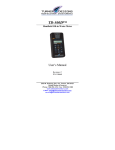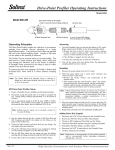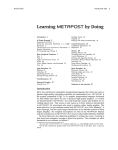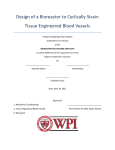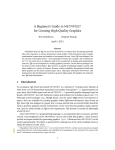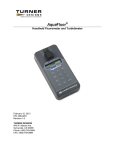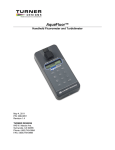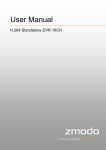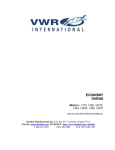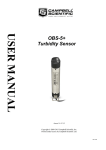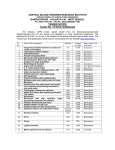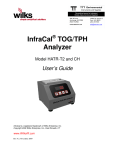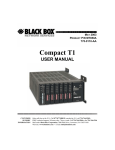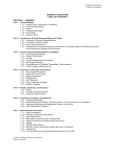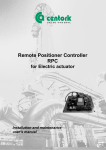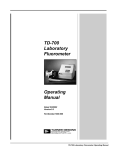Download TD-500D ™ - NAG Marine
Transcript
TD-500D ™ Handheld Oil in Water Meter User’s Manual PART-I Version: 1.1 P/N 100668 2023 N. Gateway, Ste. 101, Fresno, CA 93727 United States of America Phone: 559 253-1414 Fax: 559 253-1090 www.oilinwatermonitors.com E-Mail: [email protected] Table of Contents PART-I 1. Introduction 1.1 Description ..................................................4 1.2 Getting Started.............................................5 2. Operation...........................................................7 2.1 Principle of Operation..................................7 2.2 Channel Selection Guidelines……………...8 2.3 Cuvette Selection Guidelines………………9 2.4 TD-500D Keypad…………………………10 2.5 Instrument Power-up……………………...10 2.6 Calibration……………………………….. 11 2.7 Calibration Standard Value……………….12 2.8 Diagnostic Information…………………...12 2.9 Channel Selection.………….……………..13 3. General Considerations for Analysis 3.1 Sample Analysis……………………….....14 3.2 General Information and Precautions…….14 3.3 Linear Range……………………………...15 3.4 Sensitivity………………………………...16 3.5 Temperature Considerations……………...17 3.6 Data Quality………………………………17 4. Troubleshooting……………………………...18 5. Warranty 5.1 Terms……………………………………..19 5.2 Service During and After Warranty Period……………………………………..19 6. Appendix A Instrument Specifications……………………...22 TD-500D User’s Manual 2 PART-II 7. FastHEX Method Introduction ……………..24 8. FastHEX Method: Analysis Procedure for Lighter than Water Extraction Solvents…....26 9. Analysis Procedure for Heavier than Water Extraction Solvents………………………......29 10. Calibration Procedure for the TD-500D........33 10.1 Option 1: Calibrating with Standard Solutions……………………………………....33 10.2 Option 2: Calibrating by Correlation to an External Method………………….…………...37 11. Using the TD-500D Oil in Water Meter CheckPOINT™ Solid Reference Standard...38 12. Extraction and Calibration Procedure Method Supplies……………………………………….42 TD-500D User’s Manual 3 1. Introduction 1.1 Description The TD-500D is a dual-channel, handheld fluorometer designed for quick, easy and reliable measurements of crude oil, fuel oil, lube oil, diesel, gas condensates and refined hydrocarbons in water or soil. When properly calibrated with a correlation method or a known standard, the TD500D can be used to measure the hydrocarbon concentrations of water samples in less than 4 minutes. The TD-500D is not designed to measure gasoline, BTEX, or aromatic solvents in water or soil. Contact us about the TD-3100 bench top oil in water analyzer for measurement of gasoline, BTEX, or aromatic chemicals in water. Please contact [email protected] for more information. The dual-channel design makes the TD-500D applicable to a wide range of hydrocarbon types and concentration ranges. Channel A provides the extreme sensitivity required to monitor very low hydrocarbon concentrations and for detecting weakly fluorescent hydrocarbons such as gas condensates, diesel fuel and refined petroleum products. Channel B was designed for those applications where a wide concentration range is more important than high sensitivity. Channel B is ideal for the analysis of produced water samples where crude oil concentrations can vary from low levels to over one thousand parts-per-million. The TD-500D is normally used with a solventextraction method such as the Oil in Water TD-500D User’s Manual 4 Analysis Procedure described in Part II of this manual. In this method, the target hydrocarbon is extracted into a suitable solvent. The TD-500D measures the hydrocarbon content of the extract, and calculates the hydrocarbon content in water. NOTE: The TD-500D is not explosion proof and is not designed in any way to be used in an explosion proof designated area. 1.2 Getting Started 1.2.1 Incoming Inspection Upon receiving your instrument, please inspect everything carefully and make sure all ordered accessories are present. All shipments include: • The TD-500D Oil in Water Meter • 4 AAA Batteries • User’s Manual • Recommended Accessories (as ordered): o Carrying Case o CheckPOINTTM Solid Standard o Appropriate Cuvettes and Adapters as ordered. 1.2.2 Battery Installation 1. The battery compartment is located at the back of the instrument. Loosen the screw and remove the battery compartment cover (See Figure 1). TD-500D User’s Manual 5 2. Install the 4 AAA batteries. Orient the batteries as indicated by the diagrams inside the battery compartment. 3. Replace the battery compartment cover and tighten the screw. The cover has an o-ring, which creates a watertight seal. The battery compartment cover may be difficult to install if there is no lubrication on the o-ring. If necessary, use silicon-based grease to lightly lubricate the o-ring. Back of the TD-500D showing battery cover removed Figure 1. TD-500D Battery Compartment TD-500D User’s Manual 6 2. Operation 2.1 Principle of Operation The TD-500D responds to the fluorescent aromatic compounds in the target hydrocarbon. The instrument must be calibrated by measuring the intensity of fluorescent light that is generated by a know concentration of hydrocarbon. Once calibrated, the instrument converts the fluorescent light intensity from an unknown sample into units of concentration. Figure 2 shows the general relationship between fluorescence intensity and concentration. C ∞ Concentration Quenching -orInner Filter Effect IF Fluorescence (IF) Linear Range Limit Concentration (C) Detection Limit Figure 2. Fluorescence vs. Concentration Every hydrocarbon will have a detection limit and a linearity limit. The detection limit is the lowest concentration that the instrument can detect. The linearity limit varies with each type of hydrocarbon. The linear range is defined by the concentration span from the detection limit to the TD-500D User’s Manual 7 linearity limit. As concentration increases beyond the linearity limit, the slope of the line begins to reduce. At very high concentrations, the slope may become negative. For most crude oils the linearity limit is well beyond 1000ppm. The TD-500D must be operating in the linear range to display accurate results. The linear range can be optimized for any monitoring application by selecting the best combination of measurement channel (A or B) and cuvette size (Mini-cell or 8 mm cuvette). See Section 3, page 14 for configuration guidelines. After calibration you can perform a simple test to determine if your calibration standard is in the linear range. First select a channel and proper cuvette size and calibrate the TD-500D with a standard solution of known concentration then prepare a new standard that is half the concentration of the standard solution by mixing equal volumes of the original calibration standard and pure blank. Place the diluted standard in a sample cell, place the cell in the TD-500D and press <READ>. If the displayed result is greater than half the original standard concentration, you are beyond the linear range. The linear range is dependent upon the sample cuvette size and the optical channel of the TD-500D; thus using a smaller cuvette size and/or changing the optical channel can extend the linear range. 2.2 Channel Selection Guidelines: Channel A is generally used where high sensitivity is required. Channel A is ideal for weakly fluorescent hydrocarbons or for very low concentrations of hydrocarbons. Channel B is TD-500D User’s Manual 8 used whenever Channel A gives poor linearity over the concentration range of interest or if channel A is over range for the calibration standard. Proper channel selection depends on the type of hydrocarbon and the desired concentration range. Channel A: In most cases, use channel A for measuring following hydrocarbons in water or soil: Gas Condensate Diesel Marine Diesel Fuel Oil #6 (<1 ppm) Lube Oil Crude Oil in Produced Water (<5 ppm) Channel B: In most cases, use channel B for measuring: Crude Oil in Produced Water (0>100 ppm) 2.3 Cuvette Selection Guidelines: Use the smaller minicell cuvettes (P/N 50952) for measuring heavy crude oil and other highly fluorescent oils in water. Use the bigger 8 mm diameter cuvettes (P/N 50957) for diesel, gas condensates, lube oil and other refined hydrocarbons in water or for very low concentrations of crude oil in water. TD-500D User’s Manual 9 2.4 TD-500D Keypad Make a measurement Exit, return to Home screen Power ON/OFF Channel select Enter concentration of calibration standard Advance to next screen Calibrate Diagnostic Screen 2.5 Instrument Power-up ON/ OFF Turn the instrument face-up and press the <ON/OFF> button. The instrument should turn on and display an introduction screen with a countdown indicator in the lower right corner: T DH I T D - 5 0 0 D T DH I 1 B 0 8 0 5 5 Count-down Timer After 5 seconds, when the count-down indicator reaches zero, the TD-500D displays the “Home” screen and is ready for use: RE ADY A Channel Indicator (A or B) TD-500D User’s Manual 10 The channel indicator will display the channel that was active during the instrument’s previous use. If the display does not activate, check the batteries. Make sure they are fresh and installed in the proper orientation. If the display shows meaningless characters, replace the batteries. The TD-500D will automatically turn off if it is idle for 3 minutes. Fresh alkaline batteries will provide adequate power for over 1000 measurements. 2.6 Calibration CAL There are many ways to calibrate the TD-500D. The most popular calibration method in the USA Offshore industry is by correlation to the standard US EPA method. For details about this method and alternatives see section 10, page 34. Another way to calibrate is using a known standard made from the target oil and a blank solvent. This method is generally used in the field for quick analysis or when an official laboratory is not available. For a discussion regarding the various philosophies of calibration please contact [email protected] or visit our web site. Before the TD-500D can be used to analyze a sample, you must calibrate it with a blank and a calibration standard containing your target hydrocarbon. If you are following a solventextraction method, use the pure extraction solvent for the blank. Prepare the calibration standard by dissolving a known amount of hydrocarbon in a known volume of extraction solvent. The standard solution will then have a known TD-500D User’s Manual 11 concentration. This is the standard value (STD VAL). The TD-500D can also be calibrated by correlating the instrument readings to another oil in water analysis method i.e. US EPA 1664. NOTE: Make sure that you use the same size cuvette for blank, calibration solution and sample analysis. For Example, if you use the minicell cuvettes for blank and calibration solution then use minicell cuvettes for sample analysis also. Using different size cuvettes for calibration and sample analysis will result in incorrect readings. STD VAL 2.7 Calibration Standard Value Assign a numeric value between 1 and 9999 for your known standard solution. This is done after performing the calibration as the last step of the calibration procedure. Make sure the instrument is set to the proper channel (A or B), then use the up and down arrows to adjust the standard value. Holding this button down will activate faster scrolling. When finished, press <ESC> or <ENT> to accept the value and return to the Home screen. Note: No units are shown on the screen. 2.8 Diagnostic Information DIAG Press <DIAG> to access the diagnostic screens. Record the %FS-BLK and %FS-STD values shown on the screen for future reference. The %FS-BLK is the fluorescence response of the TD500D for the blank i.e. clean extraction solvent. The %FS-STD is the fluorescence response of the TD-500D for the calibration standard. For best performance the %FS-STD should be greater than TD-500D User’s Manual 12 0.100. The %FS-STD reading is the fluorescence value of the standard above the fluorescence value of the blank. The maximum values are 100%FS. Press <ESC> when finished to return to the Home screen. 2.9 Channel Selection A/B Press <A/B> for switching the channels on the TD-500D. There are two channels on the TD500D, channel A and channel B. Please refer to section 2.2 (page 8) for channel selection guidelines. You may switch channels by pressing <A/B> only when the “HOME” screen is displayed. NOTE 1: Each channel will store a separate calibration. NOTE 2: Analyze your samples on the calibrated channel only. For example if your TD-500D is calibrated on Channel B, then use channel B for sample analysis. Using a different channel for sample analysis will give incorrect readings. TD-500D User’s Manual 13 3. General Considerations for Analysis 3.1 Sample Analysis • Turn on the instrument. • Insert your sample in a clean cuvette and put the cuvette in the appropriate cuvette adapter. Be sure to wipe any oil or finger prints from the outside of the cuvette. • Insert the cuvette adapter in the TD-500D sample chamber and press <READ>. The instrument will measure and average the signal over a 5 second interval. • The result will be displayed on the screen. • The top left corner will display “WAIT” for 5 seconds. Once “WAIT” disappears, another sample reading can be performed. 3.2 General Information and Precautions 1. The sample compartment with the appropriate adapter accepts either the minicell cuvettes or the 8mm round cuvettes. Consult factory for questions regarding use of various cuvettes. 2. Take care not to spill samples into the sample chamber. Promptly wipe any spills. Simple alcohol rinse of the sample chamber should neutralize any potential chemical attack. TD-500D User’s Manual 14 3. The TD-500D is very sensitive and even small amounts of material from a previous sample may result in errors. Use a clean cuvette for each reading. Wipe the outside of the cuvette with a Kim Wipe or similar laboratory wipe. Do not use paper towels or kitchen wipes because the optical brighteners in the paper may cause a false reading. 4. Fill the cuvette at least 50% full; significant error will result if the cuvette is not properly filled. Use a minimum of 75 µl (0.075ml) in a minicell cuvette, and a minimum of 1 ml in an 8 mm diameter cuvette for best results. 5. The cuvette MUST BE CLEAN AND DRY on the outside when taking readings. Moisture and condensation or fingerprints on the outside can result in error. Use laboratory grade tissues or wipes for wiping the cuvettes. 6. Avoid air bubbles in the cuvette. Bubbles in samples may cause drifting of the reading. Slight tapping on the outside cuvette wall should help remove any bubbles. 7. Always make sure to analyze the samples on the calibrated channel only. Using a different channel for sample analysis will give incorrect readings. 3.3 Linear Range The linear range is the concentration range within TD-500D User’s Manual 15 which the readout of the TD-500D is directly proportional to the concentration of the hydrocarbon. You must make sure the instrument is calibrated in the linear range (see section 2.1, page7). The linear range is dependent upon the sample cuvette size and the optical channel of the TD500D; thus using a smaller cuvette size and/or changing the optical channel can extend the linear range. The glass minicell cuvettes provide a smaller cell diameter than the 8 mm round cuvettes. For heavy and highly fluorescent oils, we recommend using the minicells with channel B for the widest possible linear range. 3.4 Sensitivity The instrument’s sensitivity is measured by the %FS-STD value on the diagnostic screen. For proper operation, the %FS-STD should be greater than 0.100. The sensitivity should be checked when initially calibrating the TD-500D. The calibration and operation guidelines mentioned in this manual work with most oils. However, some refined oils and condensates do not have enough fluorescence (%FS-STD < 0.100). If the %FS-STD is less than 0.100; or if the calibration screen says “Standard < Blank, Recalibrate”, then follow the steps below: A) Make sure you are using clean solvent and clean cuvettes. B) If the TD-500D is set to channel B, then TD-500D User’s Manual 16 switch to channel A, and/or; C) Use larger cuvette, and/or; D) Use higher concentration of oil in solvent for calibrating the TD-500D. 3.5 Temperature Considerations Perform all calibrations and sample analysis at ambient temperature. 3.6 Data Quality The TD-500D is only as accurate as the standards that are used to calibrate it and the accuracy of the measurement of the standards into the solvent. This is why it is important to take care when preparing standards, samples, and blank. One should follow good laboratory practices when handling reagents and preparing standard solutions. Also, follow all solvent handling rules for the specific solvent and the specific facility. Use safety glasses with side shields or splash goggles while handling acids and solvents. Use Nitrile Exam Gloves to protect your hands. Consult your company’s safety guidelines for detailed safety instructions. TD-500D User’s Manual 17 4. Troubleshooting Following messages can appear on the TD-500D display screen: Message 1: “Low Battery” Cure 1: Replace the batteries with 4 new AAA batteries. Message 2: “Circuit Failure” Cure 2: Contact Turner Designs Hydrocarbon Instruments, Inc. according to directions in section 5.2, page 19. Message 3: “High Blank” Cure 3: Recalibrate the TD-500D with a clean blank. Message 4: “Standard too High: Recalibrate” Cure 4: a) Use lower concentration of Calibration solution; and/or b) Use smaller cuvette size for blank, calibration standard and for sample analysis; and/or c) Switch to channel B and recalibrate. NOTE: The optimum combination of channel and cuvette size will depend on the type of oil, detection limit and measurement range. TD-500D User’s Manual 18 5. Warranty 5.1 Terms Turner Designs Hydrocarbon Instruments warrants the TD-500D Oil in Water Meter and accessories to be free from defects in materials and workmanship under normal use and service for a period of one year from the date of shipment. The instrument and accessories must be installed, powered, and operated in compliance with the directions in this TD-500D User’s Manual and the instructions accompanying the accessories. Additional 12 months warranty is available at the time of order. Please consult factory. The following items are not covered under warranty: 1. Damage resulting from contact with solvents or other corrosive liquids and gases. 2. Damage resulting from contact with corrosive materials or atmosphere. 3. Damage caused by modification of the instrument. 4. Damage caused by improper handling and physical abuse of the instrument. 5.2 Service During and After Warranty Period To obtain service at any time, do the following: 1. Write or call the Turner Designs Hydrocarbon Instruments, Inc. Customer Service or Applications Departments and TD-500D User’s Manual 19 describe the nature of the problem. See contact information on page# 21. 2. Make minor adjustments or tests as suggested by Turner Designs Hydrocarbon Instruments, Inc. personnel. 3. For return to the factory, OBTAIN AN RMA (Return Material Authorization) NUMBER BEFORE SHIPPING THE INSTRUMENT TO TURNER DESIGNS HYDROCARBON INSTRUMENTS, Inc. You must ship all items associated with the instrument, including the TD-500D, the appropriate adapter, the CheckPOINT™ solid standard and the carrying case. After obtaining an RMA number, pack the instrument and accessories well, insure it, write the RMA # on the outside of the carton, and ship it to Turner Designs Hydrocarbon Instruments, Inc. prepaid. If the instrument and/or the problem is determined to be repairable under warranty, the instrument will be repaired and returned free of charge and freight costs for all customers in the contiguous continental United States. Outside the continental United States, the customer will pay all shipping costs, customs duties, and special documentation if required in connection with repair and warranty service of the unit. Out of warranty repair for the TD-500D is billed on a flat rate basis regardless of the problem. Your bill will include return shipment freight charges. NOTE: Please do not return the instrument without notice. TD-500D User’s Manual 20 Address for Return Shipments: Turner Designs Hydrocarbon Instruments, Inc. Attn: Instrument Repair RMA#____ 2023 N. Gateway Blvd., Suite 101 Fresno, CA 93727 USA Contact Information for Sales and Service Main Phone Number: +559 253-1414 Main Fax: +559 253-1090 Email (Sales): [email protected] Email (Service): [email protected] TD-500D User’s Manual 21 6. Appendix A: Instrument Specifications TD500 D Hand Held Oil in Water Meter Data Sheet Crude Oil, Condensate, diesel, lube oil, fuel oil, motor oil, diesel range organics 1 Hydrocarbons in Water 2 Ambient Temperature Min F/CMax F/C General Purpose 4 Mounting Hand / Table Top 1.75” x 3.5” x 7.25” x 8.9cm x 18.4cm) 5 Dimensions GENERAL 41/5 3 Area Classification (4.45cm 6 Weight 13.9oz (0.4kg) 7 Enclosure Material Non-Metallic Meets IP 67 standard; dustproof and waterproof 8 IP Rating 9 Power Supply Required 4 AAA Cells (1,000+ Samples) 10 Automatic Power Down After 3 minutes of inactivity 11 Local Display Yes, LCD 12 Output Signal No 13 Warranty 1 Year Factory Parts and Labor 14 Principle UV Fluorescence API Type Solvent <45 Minicell All 15 Cuvettes 16 Measurement Method 17 Compatible Solvents Technical Detail 104/40 >45 8mm All Solvent Extraction Hexane, Vertrel, AK-225, Xylene, Freon, Horiba, (most other extraction solvents, consult factory) 18 Total Elapsed Time for Measurement Method< 4min or owners preference 19 Accuracy Better than 2% of Full Scale 20 Repeatability 22 Sensitivity Better than 2% of Full Scale Up to 1000 ppm Hydrocarbon Dependent 1 ppm 23 Calibration Single-point and blank 24 Response Time 5 Seconds Low battery, circuit failure, High blank 21 Linear Range 25 Alarms 26 Warm Up TD-500D User’s Manual 5 seconds 22 Oil in Water Analysis Procedure TD-500DTM Oil in Water Meter User’s Manual PART-II Version: 1.0 P/N 100668 2023 N. Gateway, Ste. 101, Fresno, CA 93727 United States of America Phone: 559 253-1414 Fax: 559 253-1090 Internet: http://www.oilinwatermonitors.com E-Mail: [email protected] TD-500D User’s Manual 23 7. fastHEXTM Method Introduction Introduction The fastHEXTM method for the TD-500D was developed to provide a simple, rapid, accurate, safe and environmentally friendly field procedure for the analysis of oil and grease in water. The TD-500D measures the oil content of a water sample by measuring the fluorescent light emitted by oil that has been extracted into hexane. Hexane is an inexpensive, non-fluorescent, organic solvent that efficiently extracts all types of crude oil, and separates out quickly on top of the water sample. The fastHEXTM method has been in use for several years, and has been field-proven to give results that correlate well to US EPA Method 1664 and other official oil and grease methods. The entire procedure, from taking a water sample to recording results, takes less than 4 minutes. Because the method uses inexpensive, disposable bottles and cuvettes, solvent waste is reduced to a minimum. Also, unlike Freon and other halogenated or chlorinated solvents, hexane can be disposed of in most oil and gas facilities without worrying about physical exposure. Other Methods: There have been many oil and grease analysis methods developed over the years and many of them are useful. If you have questions regarding the viability of any method please consult our Service department or the appropriate department in your own company. TD-500D User’s Manual 24 Alternative Solvents Although the fastHEXTM method was originally intended to use hexane, its solvent extraction and measurement procedures can also be applied to other lighter-than-water solvents (xylene, petroleum ether, etc.). In addition, the procedure can be modified allowing use of a variety of heavier-than-water solvents (Vertrel MCA, Ashikleen AK-225, perchloroethylene, etc.). Analysis procedures for lighter-than-water solvents and heavier-than-water solvents are given in Sections 8 (page 26) and 9 (page 29), respectively. Important note regarding solvents: Some solvents, especially Vertrel MCA, Ashikleen AK-225 and chloroform, can damage the TD-500D if left in contact with the plastic parts. If you spill solvents on the case or inside the sample compartment, flush the contacted area immediately with isopropyl alcohol and dry the area with a non-abrasive lab tissue. Always follow safety rules for handling and disposing of solvents. TD-500D User’s Manual 25 8. fastHEX TM Method: Analysis Procedure for Lighter than Water Extraction Solvents (See page 33 for Calibration Procedure) This procedure is for use with lighter than water extraction solvents such as: Hexane Cyclohexane Heptane Octane Xylenes (may give high blank reading) Toluene (may give high blank reading) NOTE 1: Please use this procedure even if your solvent is not listed above and you are using lighter than water extraction solvent. NOTE 2: If you are using heavier than water extraction solvent then refer to section 9 (page 29) of this manual for heavier than water extraction solvent analysis procedure. Analysis Procedure: 1. Collect 100 ml of contaminated water in a clean, graduated prescription bottle or suitable graduated glass container. 2. Add 6N HCl until the pH of the water sample is <2. Check the pH with pH paper. Note: Depending on the method philosophy of the facility, the sample can be measured at normal pH. 3. Add 10 ml of extraction solvent and securely cap the bottle. TD-500D User’s Manual 26 4. Extract oil from the water by vigorously shaking the bottle for 2 minutes. 5. Allow the extraction solvent to separate from the water for approximately 1 minute. If the extraction solvent is trapped in an emulsion; break the emulsion by agitating with a clean pipette. Allow the extract to sit for several minutes after agitating the emulsion. This will allow the solvent to separate from the water. The solvent extract will be floating on top of the water. 6. Carefully release the pressure from the bottle. 7. Fill the appropriate cuvette (Minicell or 8 mm cuvette) ¾ full with the solvent extract. Wipe the outside of the cuvette with a clean laboratory grade tissue or cloth to remove any liquid, dirt or oil that might be present. 8. Insert the cuvette into the TD-500D cuvette holder in the sample compartment and close the lid. 9. If the TD-500D is off, press the <ON/OFF> button and allow the instrument to proceed to the end of the countdown period. 10. Make sure the proper channel (A or B) is shown in the lower left-hand corner of the display. If it is not, press the <A/B> button until the correct channel appears. 11. Press the <READ> button and then record the reading after the “WAIT” message disappears. TD-500D User’s Manual 27 12. If the TD-500D was calibrated using a lookup table, use the look-up table to convert the reading to oil concentration. 13. Dispose of the water, extraction solvent, cuvette and prescription bottle in a safe, environmentally responsible manner, in accordance with your company’s procedures. NOTE 3: If the TD-500D Oil in Water Meter reads “OVER”, or the sample reads higher than the correlation chart or look-up table, this means the oil and grease concentration is too concentrated. Follow the steps below to overcome this issue: 1. Dilute the solvent extract 5X by combining 1ml of solvent extract with 4 ml of clean solvent and mix the sample. 2. Measure the diluted sample (Step 7 through 11 on page 27). 3. Record the concentration of the diluted sample extract using the correlation chart (Step 11 on page 27). 4. Multiply the result from Step 11 on page 27 by five (5) to calculate the true oil and grease result in the produced water sample. TD-500D User’s Manual 28 9. Analysis Procedure for Heavier than Water Extraction Solvents (See page 33 for Calibration Procedure) This procedure is for use with heavier than water extraction solvents such as: Vertrel MCA Freon Ashikleen AK-225 Chloroform Carbon Tetrachloride Horiba S-316 Methylene Chloride NOTE 1: Please use this procedure even if your solvent is not listed above and you are using heavier than water extraction solvent. NOTE 2: If you are using lighter than water extraction solvent then refer to section 8 (page 26) of this manual for lighter than water extraction solvent analysis procedure. Analysis Procedure: 1. Collect 100 ml of produced water in a clean, graduated prescription bottle. 2. Add 6N HCl until the pH of the water sample is <2. Check the pH with pH paper. 3. Add 10 ml of extraction solvent and securely cap the prescription bottle with a clean, Teflon-lined Septum Cap. 4. Extract oil from the water by vigorously shaking the prescription bottle for 2 minutes. TD-500D User’s Manual 29 5. Allow the extraction solvent to separate from the water for approximately 1 minute. If the extraction solvent is trapped in an emulsion; break the emulsion by agitating with a clean pipette. Allow the extract to sit for several minutes after agitating the emulsion. This will allow the solvent to separate from the water. The solvent extract will be on the bottom of the bottle, underneath the water. 6. Place a blunt needle on the end of a 3 ml plastic syringe. Push the syringe plunger all the way in. 7. Turn the prescription bottle upside down and allow the solvent extract to settle on top of the Teflon-lined Septum Cap. 8. While holding the prescription bottle upside down, insert the needle through the Teflonlined Septum Cap far enough for the end of the needle to be in the solvent extract. 9. By pulling the syringe plunger out, withdraw 1-1.5 ml of solvent extract. 10. Inject the solvent extract into the cuvette (Minicell or 8 mm cuvette, the same type used for calibration) until the cuvette is ¾ full. 11. Wipe the outside of the cuvette with a clean tissue or cloth to remove any liquid, dirt or oil that might be present. 12. Insert the cuvette into the TD-500D sample compartment and close the lid. TD-500D User’s Manual 30 13. If the TD-500D is off, press the <ON/OFF> button and allow the instrument to proceed to the end of the countdown period. 14. Make sure the proper channel (A or B) is shown in the lower left-hand corner of the display. If it is not, press the <A/B> button until the correct channel appears. 15. Press the <READ> button and then record the reading after the “WAIT” message disappears. 16. If the TD-500D was calibrated using a loopup table, use the loop-up table to convert the reading to oil concentration. 17. Dispose of the water, extraction solvent, cuvette and prescription bottle in a safe, environmentally responsible manner, in accordance with your company’s procedures. NOTE 3: If the TD-500D Oil in Water Meter reads “OVER”, or the sample reads higher than the correlation chart or look-up table, this means the oil and grease concentration is too concentrated. Following steps should be performed to dilute the sample extract: 1. Dilute the solvent extract 5X by combining 1ml of solvent extract with 4 ml of clean extraction solvent and mix the sample. 2. Measure the diluted sample using the TD500D Oil in Water Meter (Step 5 through 9 on page 30). TD-500D User’s Manual 31 3. Record the concentration of the diluted sample extract using the correlation chart (Step 9 on page 30). 4. Multiply the result from Step 9 on page 30 by five (5) to calculate the true oil and grease result in the produced water sample. TD-500D User’s Manual 32 10. Calibration Procedure for the TD-500D (For all extraction solvents) Option 1: Calibrating with Standard Solutions The TD-500D Oil in Water Meter can be calibrated with a standard solution of oil in extraction solvent. The standard solution (known oil concentration) is prepared by dissolving a known amount of oil in a known volume of extraction solvent. The instrument is calibrated by relating measured fluorescence response to the concentration of oil in the standard. Calibration Standards Sample preparation for the TD-500D Oil in Water Analysis Methods involves extracting the oil from a 100 ml water sample into 10 ml of solvent. Therefore, the oil concentration in the extraction solvent will always be 10X greater than the oil concentration of the water sample. For example, a 100 ppm oil concentration in a water sample will give a 1000 ppm oil concentration in the solvent extract. This 10X concentration factor is affected during calibration i.e. if you want to calibrate the TD-500D for 100 ppm oil in water, you would use a standard solution of 1000 ppm in the exaction solvent. Calibration Standard Preparation Part 1 – Prepare a 10,000 ppm Stock Standard. 1. Pipette 1 ml (1000 µl) of oil into a 100 ml volumetric flask that is approximately half full of extraction solvent. TD-500D User’s Manual 33 2. Cap the flask and shake it to dissolve the oil. 3. Fill the 100 ml volumetric flask to the mark with clean extraction solvent. 4. Cap and shake the flask to mix. Part 2 – Prepare a Calibration Standard Select a concentration that is equal to the maximum anticipated in your water samples. Prepare a Calibration Standard by diluting the Stock Standard with clean solvent. Recipes for preparing several typical concentrations are given in Table 1. To prepare the Calibration Standard shown in column 1, pipette the Stock Standard volume given in column 3 into a 100 ml volumetric flask, then fill the flask to the 100 ml mark with clean solvent. Calibration Standard, ppm 5,000 2,500 1,000 500 250 100 Oil in Water Equiv., ppm 500 250 100 50 25 10 Stock Standard Volume 50 ml 25 ml 10 ml 5.0 ml 2.5 ml 1.0 ml Table 1. Calibration Standards Calibrate the TD-500D Oil in Water Meter 1. Before calibration begins, you must select a TD-500D channel (A or B) and a cuvette size (Minicell cuvette or 8 mm cuvette). See section 2.2, page 8 for channel selection TD-500D User’s Manual 34 guidelines. See section 2.3, page 9 for cuvette selection guidelines. 2. Prepare a Blank by filling a cuvette with clean extraction solvent. Wipe the outside of the cuvette with a clean laboratory grade tissue to remove any liquid, dirt or oil that might be present. 3. Insert the Blank cuvette into the TD-500D sample compartment and close the lid. 4. If the TD-500D is off, press the <ON/OFF> button and allow the instrument to proceed to the end of the countdown period. 5. Make sure the proper channel (A or B) is shown in the lower left-hand corner of the display. If it is not, press the <A/B> button until the correct channel appears. 6. Press the <CAL> button and then press <ENT>. 7. Press <ENT> to read the response of the Blank. 8. Fill a new cuvette with the Calibration Standard. Wipe the outside of the cuvette with a clean laboratory grade tissue to remove any liquid, dirt or oil that might be present. 9. Insert the Calibration Standard cuvette into the TD-500D sample compartment and close the lid. 10. Press <ENT> to read the response of the Calibration Standard. TD-500D User’s Manual 35 11. Press <ENT> within 10 seconds to store the calibration. 12. Press the <STD VAL> button. 13. Enter the STD VAL as 1/10 of the concentration of the Calibration Standard. Adjust the Calibration Value using the <▲> and <▼> buttons. Press either button once for each increment of STD VAL. Holding either of these buttons down will activate faster scrolling to the desired value. 14. Press <ENT> to accept the STD VAL. The calibration is now complete. The calibration will be stored and maintained when the instrument is turned off. Notes on error conditions and remedial procedures: Following messages can appear on the TD-500D display screen while calibrating the TD-500D: Message 1: “High Blank” Cure 1: Recalibrate the TD-500D with a clean blank. Message 2: “Standard too High: Recalibrate” Cure 2: a) Use lower concentration of calibration solution; and/or b) Use smaller cuvette size for blank, calibration standard and for sample analysis; and/or c) Switch to channel B TD-500D User’s Manual 36 Option 2: Calibrating by Correlation to an External Method (i.e. US EPA 1664) or other standard oil and grease method. The TD-500D Oil in Water Meter can be calibrated to give oil concentrations equivalent to an external analysis method. This method has been used extensively for offshore platforms in the Gulf of Mexico to give results equivalent to EPA Method 1664. The method is based on establishing a correlation between the TD-500D response of the extracted sample and the oil concentration determined by the external method performed at an appropriate analysis laboratory. Procedures for performing this type of calibration depend strongly on the type of oil, the desired analysis range and the nature of the external method. Please consult the factory for additional information and guidance. TD-500D User’s Manual 37 11. Using the TD-500D Oil in Water Meter CheckPOINT™ Solid Reference Standard The CheckPOINT™ solid reference standard is used to verify the TD-500D Oil in Water Meter calibration and performance prior to sample analysis procedure. The CheckPoint™ solid standard contains a fiber that produces an adjustable signal that can be set to be equal to the calibration solution. The fiber is covered by an attenuation screw. Opening the attenuation screw (counter-clockwise rotation) will increase the exposure of the fiber and hence will increase the reading on the TD-500D. Closing the attenuation screw (clockwise rotation) will decrease the readings on the TD-500D. The following procedure describes how a calibration value is assigned to the CheckPOINT™ solid standard. Once the CheckPOINT™ solid standard has a calibration value assigned to it, the TD-500D Oil in Water Meter can be recalibrated in the field as necessary. The CheckPOINT™ solid standard is also used to verify instrument performance or calibration stability. Adjusting the CheckPOINT™ Solid Standard 1. Calibrate the TD-500D Oil in Water Meter by Option 1 (page 33) or by Option 2 (page 37) mentioned in this manual. 2. Remove the cuvette and cuvette adapter. 3. Remove the CheckPOINTTM solid standard from its storage box. Using the 0.050” Allen wrench provided, loosen the locking setscrew TD-500D User’s Manual 38 on the back of the solid standard by turning it counterclockwise one turn. Picture 1. Loosening the locking setscrew on the backside of the adjustable CheckPOINT™ Solid Reference Standard. 4. Insert the CheckPOINT™ solid standard with the “dog-ear” handle positioned closest to the back of the sample compartment. Picture 2. Placing the adjustable CheckPOINT™ Solid Reference Standard in the TD-500D. 5. If the TD-500D Oil in Water Meter is off, press the <ON/OFF> button and allow the instrument to proceed through the countdown period. 6. Press the <READ> button and then record the reading after the “WAIT” message disappears. TD-500D User’s Manual 39 7. Open the lid and use the 3/32” Allen wrench provided to adjust the attenuation screw through the hole at the top of the solid standard to increase or decrease the value displayed on the screen. Turning the screw counter-clockwise will increase the reading. Picture 3. Adjusting the value on the CheckPOINT™ Solid Reference Standard by turning the attenuation screw. 8. Repeat steps 5-8 until the solid standard reads the concentration value of interest. 9. At this point, remove the solid standard and turn the locking setscrew until it just makes contact with the attenuation screw – do not over tighten. 10. Record the value of the CheckPOINT™ solid standard on the adhesive label on the bottom of the CheckPOINTTM Solid Standard. 11. Remove the CheckPOINT™ solid standard. 12. Recalibrate the TD-500D Oil in Water Meter using the value of the CheckPOINT™ Solid Standard obtained in step 11 as the Standard Value (STD VAL). TD-500D User’s Manual 40 On a daily basis, prior to sample analysis, use the CheckPOINT™ to verify TD-500D Oil in Water Meter calibration. If the CheckPOINT™ value has changed by greater than +/- 10% of its assigned value, then, blank with clean extraction solvent and recalibrate the TD-500D Oil in Water Meter using the CheckPOINT™ solid standard. TD-500D User’s Manual 41 12. Extraction and Calibration Procedure Method Supplies The TD-500D can be purchased with the extraction kits for heavier and lighter than water solvents. These extraction kits have enough supplies for approximately 96 sample analysis each and they include necessary laboratory supplies and glassware required for the extraction procedure. Extraction solvent, hydrochloric acid, Isopropyl alcohol, and detergents and liquids are not provided in the Extraction Kit. The following list of items are included in the Extraction Kits: Extraction Starter Kit for Lighter than Water Solvents (P/N 100590) Description Disposable Glass Prescription Bottles with Caps, 180 ml 25 ml Glass Graduated Cylinder 250 ml Plastic Squirt Wash Bottles pH Paper Indicator Strips, Universal 0-14 Glass Sample Vials 20 ml with Teflon Lined Caps Plastic Disposable Transfer Pipette TD-500D User’s Manual Quantity 2 cases (48 per case) 2 Part No. 100585 2 100631 1 pack/100 strips per pack 2 100373 Pack of 100 100374 100653 100621 42 Extraction Starter Kit for Heavier Than Water Solvents (P/N 100629) Description Disposable Glass Prescription Bottles with Caps, 180 ml Teflon Lined Septum Caps Disposable Syringe, 3 ml Leur Lok Needles, SS with Blunt end 25 ml Glass Graduated Cylinder 250 ml Plastic Squirt Wash Bottles pH Paper Indicator Strips, Universal 0-14 Glass Sample Vials 20 ml with Teflon Lined Caps Plastic Disposable Transfer Pipette Quantity 2 cases (48 per case) Part No. 100585 96 100632 1 pack (100 per pack) 2 100651 2 100653 2 100631 1 pack/100 strips per pack 2 100373 Pack of 100 100374 100652 100621 The TD-500D Calibration Kit includes the necessary laboratory supplies required for preparing samples and for making known oil standards for calibrating the TD500D. The TD-500D Calibration kit is sufficient for 50 to 80 calibrations. The following list of items are included in the TD500D Calibration Kit: TD-500D User’s Manual 43 TD-500D Calibration Kit (P/N 100367) Description 100 ml Glass Volumetric Flask with Teflon Lined Cap 10-100 Microliter Digital Micropipette 100 Microliter Disposable Plastic Pipette Tips 10 ml Glass Graduated Cylinder-Hexagonal Base 50 ml Glass Graduated Cylinder-Hexagonal Base pH Paper Indicator Strips, Universal 0-14 Plastic Disposable Transfer Pipette Quantity 3 Part No. 100368 1 100369 1 Pack of 96 tips 2 100370 100371 2 100372 1 pack/100 strips per pack Pack of 100 100373 100374 NOTE: VWR Scientific is a recommended supplier for lab equipment, but alternative suppliers may be used if similar equipment is purchased. VWR Scientific’s website address is www.vwrsp.com. Turner Designs Hydrocarbon Instruments Telephone Number VWR Scientific Telephone Number 559-253-1414 800-932-5000 NOTE: The cuvette choice may be dictated by the application. Please perform the linearity and sensitivity checks described in section 2.1, page 7 and section 3.4, page 16 of the TD500D Oil in Water Meter User’s Manual to verify the cuvette choice. TD-500D User’s Manual 44












































